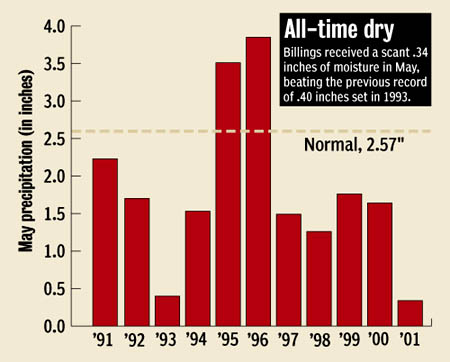|
High
and dry: Moisture level sinks to record low
May
usually is Billings’ wettest month, with 2.57 inches of precipitation
on average. The 0.34 inch equates to 13 percent of the normal moisture
for the month, Canepa said. “It would take a lot to erase, or
make up, that deficit and come out ahead,” Canepa said. May 2000
had 1.64 inches of precipitation and May 1999 had 1.76 inches, according
to NWS records. Looking back a few years, 3.85 inches fell in 1996 and
3.51 inches in 1995.
The shocking numbers have Billings resident Albert Ortmann hoping his
well doesn’t dry up. Ortmann dug a 21-foot well at his home on
Yellowstone Avenue more than a decade ago. The well water has kept
Ortmann’s tomato and strawberry plants, roses and other flowers
flourishing and his city water bill reasonable, he said.“But I’d
rather have the rain,” Ortmann said.
So would plants, according to Amy Grandpre, horticulture assistant with
the Yellowstone County Extension Service. Plants prefer the deep water
that a good steady rain will provide and Grandpre challenged people to
try to emulate that kind of soaking. Most people don’t water enough,
she said. “Put out a coffee can and see what you are throwing
out there,” Grandpre said. “A lot of people are only putting out
about a quarter-inch. That’s fumes in this hot weather.”
Lawn, flowers and vegetables need a full inch of water, Grandpre said.
With lawn, the water has to get down four to six inches to feed the
roots and hold in the ground, she said. Trees and shrubs need about two
inches of water, not as often, Grandpre said, but so that it runs deep
enough to get below the lawn. Grandpre also reminded people that trees
older than three or four years need to be watered from the trunk out to
their canopies to reach the feeder roots.
Soil conditions will affect the need for watering. Soil can vary from
sand to gravel to clay all within one lot, Grandpre said. To help
determine when to water, she suggests using a moisture meter, like the
ones that work for house plants. “Otherwise it’s just
guesswork,” Grandpre said. “We can’t see under the
surface.”
‘Emergency measures’
The early
peak of the Yellowstone River and the dwindling snowpack in the
Beartooths are easily seen, however. People who fear being left high and
dry this summer are making plans now. The Yellowstone County
Conservation District is seeing a surge in people who are considering
“emergency measures” to get water to where it’s needed, said
Laverne Ivie, a district employee.
“People are getting concerned and starting to develop plans to get
water to structures, agriculture and industry,” Ivie said. The
elected Board of Supervisors of the district issues one of about five
permits required to work in or around perennially flowing streams.
It’s early in the year, but people are starting to apply for Natural
Streambed and Land Preservation Act permits, also known as the
“three-ten permit,” she said.
“We’re seeing quite an increase in applications and from people I
wouldn’t have guessed we’d get these types of applications from,”
Ivie said. “They are worried.” The district usually receives
permits from people who want to deal with erosion problems caused by
high water, Ivie said. This year they are looking for ways to divert
water to get it to the areas it’s needed. Ivie said that could include
diversion dams or other temporary concrete structures that move water to
intakes without long-term effects on the health of the river.
“Because of
the extreme drought conditions, there may be things placed in the river
that are not aesthetically pretty, but people can be assured they are
only temporary and based on sound science,” Ivie said.
Prospects
The
Billings area normally has received about 7 inches of precipitation by the
end of May, according to the National Weather Service, which determines
“normal” by averaging 30 years of weather data. This year Billings has
recorded only 3.46 inches, or 3.55 inches less than normal. Perched in the
shade on his porch, Ortmann compared this year’s dry May to the fires of
1988, when it was said only an act of God would bring relief. “Pray for
rain,” Ortmann said. “I think that’s probably the best answer.”

|
